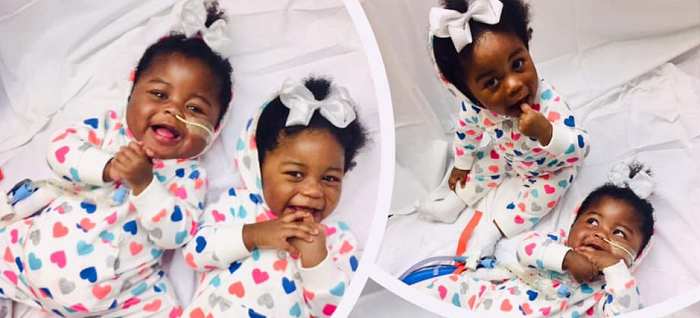 Amani Jackson and her identical twin sister, Amira, possess a rare bond that began in their mother’s womb.
Amani Jackson and her identical twin sister, Amira, possess a rare bond that began in their mother’s womb.
Up until the moment they were born, grasping on to one another, their bond remained unbroken.
It wasn’t until surgeons noticed one of them wasn’t quite like the other, that they needed to part ways.
“Although they were both premature, Amira came out healthy as can be,” said their mother, Stranje Pittman. “However, as soon as the doctor saw Amani, they knew something was wrong. Before I knew it, she was rushed out of the operating room and immediately taken to Seattle Children’s.”
Experiencing complications after giving birth, Pittman laid in the hospital anxiously waiting to be released so she could be reunited with her baby girls and see how Amani was doing.
“Almost two weeks later, I was finally able to see Amani,” said Pittman. “The moment I saw her, I just broke down. I remembered before I gave birth, I was told by some doctors that Amani wasn’t going to make it — but sure enough, there she was in the hospital, being a little fighter.”
A rare discovery
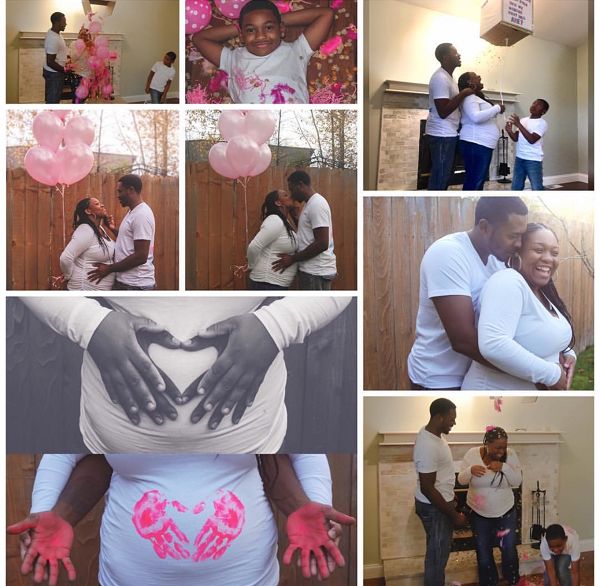
In her hometown of Anchorage, Alaska, Pittman learned she was pregnant with twins during her 8-week check-up.
“I was in complete shock that I would be having twins — but the news didn’t end there,” said Pittman. “I learned that I was expecting a rare type of high-risk pregnancy.”
Only occurring in approximately 1% of all identical twin pregnancies, Pittman was carrying monoamniotic-monochorionic twins, or “mono-mono” twins for short.
Unlike most identical twins that form from a single fertilized egg, which eventually splits into two individual embryos, mono-mono twins develop when an embryo does not split, causing them to share both the placenta and amniotic sac.
“At my 12-week ultrasound, they noticed that Amani wasn’t moving much,” said Pittman. “I found out that she had omphalocele, which was concerning since I was already having a high-risk pregnancy.”
Omphalocele occurs when the abdomen wall does not form fully before birth. Organs that are normally in the abdomen are outside of the baby’s body. The organs are covered by a thin, clear membrane instead of muscle and skin.
“With mono-mono twins, it is recommended that you stay at the hospital at 24 to 26 weeks until delivery for close monitoring,” said Pittman. “When I went in for my hospital stay in Anchorage, they found out that Amani had even more health issues than just the omphalocele.”
At 27 weeks, Pittman was told she needed to be transferred to Seattle where there was better access to the complex medical care she needed.
“I was heartbroken because I had to leave my family behind,” said Pittman, “but I knew it was for the best and that we would soon be reunited once the twins arrived.”
Pittman remained optimistic until her delivery day, when her world was turned upside down.
A unique lifesaving surgery
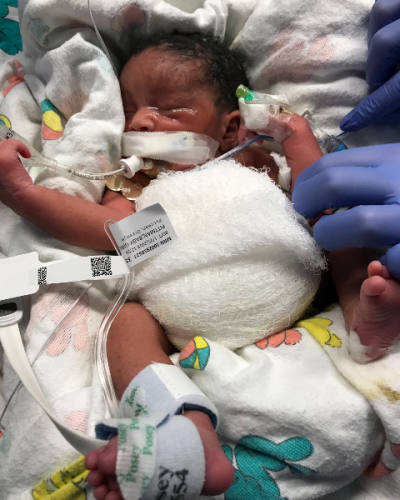
“I gave birth at 32 weeks via C-section,” said Pittman. “At first I thought everything was going well; Amira seemed perfectly normal – but then I saw Amani, and my heart sank.”
Amani was gasping for air and doctors immediately advised she be transferred to Seattle Children’s.
“I didn’t get to see Amani until almost two weeks later because I had to stay in the hospital,” said Pittman. “As soon as I saw her and held her in my arms, I burst into tears.”
Pittman learned that Amani had a laundry list of medical issues and had to remain in the Neonatal Intensive Care Unit (NICU) for three months.
“Amani was diagnosed with a rare and complicated birth defect called OEIS syndrome, also known as cloacal exstrophy,” said Dr. Caitlin Smith of Seattle Children’s Pediatric General and Thoracic Surgery Clinic and Reconstructive Pelvic Medicine Program. “This affects the development of the lower abdominal structures causing omphalocele; abnormalities in the bladder, rectum and anus; and spinal defects.”
Cloacal exstrophy is very rare and happens in about 1 in 200,000 to 400,000 births. Seattle Children’s treats approximately one case per year.
“Infants with cloacal exstrophy require a series of surgeries,” said Smith. “Amani’s situation was unique in that we first did a bowel surgery so she could be fed, but left the omphalocele in place due to other issues that Amani had.”
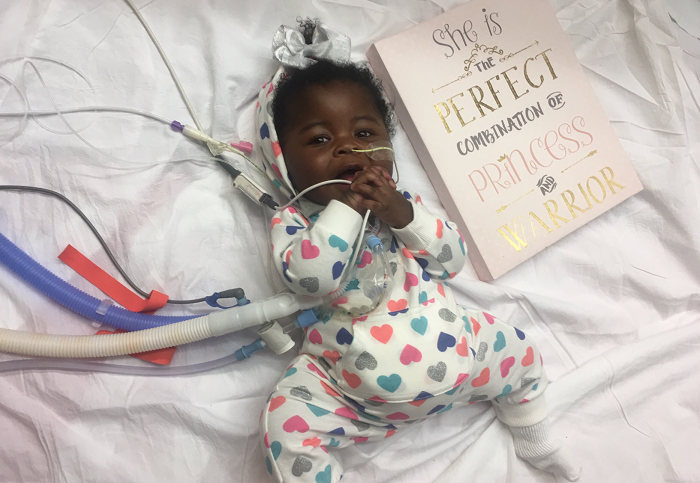
In April 2018, Amani underwent her first surgery at 4 months old.
“The surgery was successful and she’s doing amazingly well at this time,” said Smith. “Amani is stable, and now she has to wait until she grows big enough to have her next surgery.”
Although Amani won’t be getting another surgery until she’s 2 or 3 years old, she still has many other health issues that need to be addressed including chronic lung disease.
“I know she has a long journey ahead,” said Pittman. “We’re not sure what to expect, but the team at Seattle Children’s has been nothing but positive which gives me a lot of hope for Amani.”
A milestone reunites a family
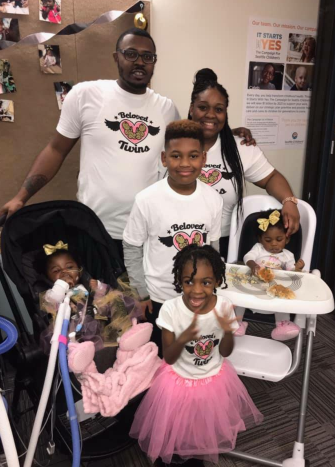
On Jan. 26, 2019, a little more than 365 days after Amani and her sister Amira were first separated, they reunited for a special day – their first birthday.
With the help of Amani’s care team at Seattle Children’s, Pittman was able to throw a party for her girls at the hospital.
“I’ve been super emotional thinking about how far we’ve come,” said Pittman. “I’m so happy to see that Amani gets to celebrate her birthday with her best friend and sister, Amira.”
As a former baker and cake decorator, Pittman whipped up several sweet treats, including a pink and gold cake topped with white angel wings.
“I wanted to make the party angel-themed because they’re both a miracle to me,” said Pittman.
Dressed in matching pink tutus and gold hair bows, Amira accompanied Amani as she left her unit for the first time since arriving at the hospital.
As the twins made their grand party entrance, they were warmly greeted by a large group of friends and family, some of who traveled all the way from Alaska, wearing matching t-shirts that said ‘Beloved Twins.’
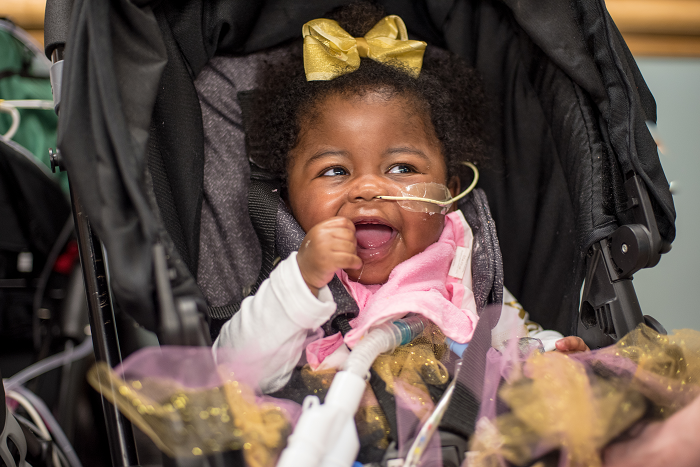
Even Smith dropped by to join the festivities and wish the girls a happy birthday.
“I’m so grateful for my friends and family who have supported us, as well as the amazing team at Seattle Children’s,” said Pittman. “I couldn’t have done it without them.”
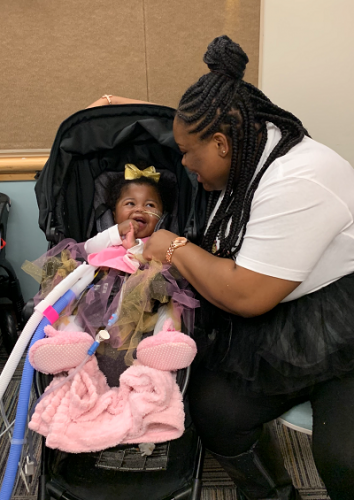
While it’s not certain as to when Amani might be able to go home due to the complexity of her medical issues, Pittman remains optimistic.
“I’m not sure what the future will hold for Amani and our family,” said Pittman, “but for now I’m working to instill as much confidence in Amani as I can, because I know it may not be easy for her as she gets older.”
Smith has witnessed Amani’s unwavering strength and credits Pittman and her family for their commitment in helping to improve Amani’s health.
“Amani is an amazing little girl and her family has been so wonderful,” said Smith. “They’ve had to cross many hurdles, but they continue moving forward. Amani is so lucky to have them.”
Pittman can’t wait for the day she can bring Amani home and be back together with her whole family under one roof.
“The name Amani means ‘faith,’” said Pittman, “and even though there will be rough days ahead, I have faith that she will get to live the normal and happy life she deserves.”

